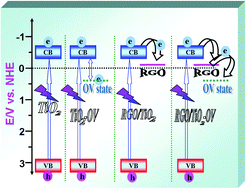Study of the role of oxygen vacancies as active sites in reduced graphene oxide-modified TiO2†
Abstract
In recent years, substantial efforts have been devoted to exploring reduced graphene oxide/TiO2 (RGO/TiO2) composite materials; however, there is still a paucity of reports on the construction of reduced graphene oxide/TiO2 with oxygen vacancies (RGO/TiO2-OV) via a facile two-step wet chemistry approach. In this work, we show a proof-of-concept study follow RGO introduced into TiO2 with oxygen vacancies, the role of oxygen vacancies as active sites in reduced graphene oxide-modified TiO2. The photocatalytic performance and related properties of blank-TiO2, blank-TiO2 with oxygen vacancies (blank-TiO2-OV), RGO/TiO2, and RGO/TiO2-OV were comparatively studied. It was found that due to the incorporation of RGO, RGO/TiO2 and RGO/TiO2-OV exhibit a higher photocatalytic performance under simulated solar light irradiation than their counterparts without rGO. More importantly, it was found that blank-TiO2 has a higher photocatalytic activity than blank-TiO2-OV under simulated solar light irradiation. However, RGO/TiO2 shows a lower photocatalytic activity than rGO/TiO2-OV. By a series of combined techniques, we found that the introduction of a component, such as RGO, with the matched energy band to TiO2 could lead to the formation of a long-lived electron-transfer state, thus prolonging the lifetime of the photogenerated charge carriers. Furthermore, during the photocatalytic process, RGO could tune the role of oxygen vacancies in TiO2 from recombination centers to active sites. These findings are of great significance for the design of effective photocatalytic materials in the field of solar energy conversion.



 Please wait while we load your content...
Please wait while we load your content...